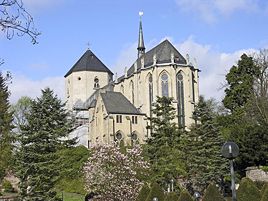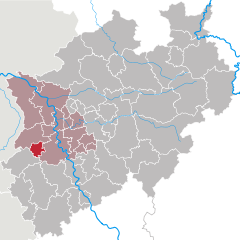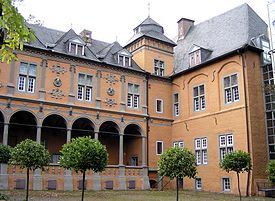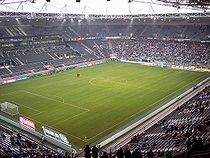- Mönchengladbach
-
Mönchengladbach Mönchengladbach Minster 
Coordinates 51°12′0″N 6°26′0″E / 51.2°N 6.433333°ECoordinates: 51°12′0″N 6°26′0″E / 51.2°N 6.433333°E Administration Country Germany State North Rhine-Westphalia Admin. region Düsseldorf District Urban district Lord Mayor Norbert Bude (SPD) Basic statistics Area 170.43 km2 (65.80 sq mi) Elevation 70 m (230 ft) Population 257,993 (31 December 2010)[1] - Density 1,514 /km2 (3,921 /sq mi) Other information Time zone CET/CEST (UTC+1/+2) Licence plate MG Postal codes 41001–41239 Area codes 02161, 02166 Website www.moenchengladbach.de Mönchengladbach (German pronunciation: [mœnçənˈɡlatbax]), formerly known as Münchengladbach, is a city in North Rhine-Westphalia, Germany. It is located west of the Rhine half way between Düsseldorf and the Dutch border.
Mönchengladbach is home of the football club Borussia Mönchengladbach, Formula One race car drivers Nick Heidfeld and Heinz-Harald Frentzen, author/cartoonist Walter Moers, cabaret artist Volker Pispers, and the philosopher Hans Jonas.
Contents
History
Name and origins
The original name of the city was Gladbach, which is even today often applied to the town. To distinguish the town from another town of the same name (the present Bergisch Gladbach) it took the name München-Gladbach in 1888. This spelling could mislead people to think that Gladbach was a borough of Munich (München in German), and consequently the name was changed to Mönchen Gladbach in 1950 and Mönchengladbach in 1960.
The origin of the town was an abbey founded in 974. It was named after the Gladbach, a narrow brook, that runs subterraneously today. The abbey and adjoining villages became a town in the 14th century. The town of Rheydt is located nearby and is incorporated into Mönchengladbach today.
Early history
The first settlements in the area of Mönchengladbach are approximately 300,000–400,000 years old and show remains of Homo erectus and Neanderthal. There are numerous cairns from the Neolithic and the Bronze Age.
The history of Mönchengladbach began with the construction of the Gladbach Minster and the founding of an abbey in the year 974 by Gero, Archbishop of Cologne, and his companion, the monk Sandrad of Trier.
To advance the settlement, the monks created a market north of the church in the 12th century. Craftsmen settled near the market. Gladbach received its town charter in 1364–1366. The "town" got a town wall made of stone, which had to be maintained by the citizens. Remains of that wall can be found at the Geroweiher, as can remains of the "Thick Tower", an old fortified tower at the Waldhausener hill. Until the end of the 18th century the city belonged to the department of Grevenbroich within the duchy of Jülich.
On October 4, 1794 French revolution army troops marched into the town, one day before the fortress Jülich had been handed over. When the Holy Roman Emperor Francis II conveyed the left bank of the river Rhine to France with the Treaty of Lunéville in 1801, Gladbach fell under French religion laws. This was the end for the abbey, and the monastery was closed. On October 31, 1802, the last 31 monks left the monastery. The tremendous abbey library, well known outside of Germany, was scattered or destroyed.
From 1798 until 1814, the Mairie Gladbach was part of Kanton Odenkirchen, Arrondissement Krefeld, of the French Département de la Roer.
Recent history
In 1815, Gladbach became part of the Kingdom of Prussia and seat of the Landkreis Gladbach, which was dissolved in 1929. In 1815 Gladbach became seat of the Bürgermeisterei (Office of mayor), which was split in 1859 into two parts: the City of Gladbach and Office of Mayor Obergeburth. The latter was renamed to München-Gladbach-Land in 1907. When the Prussian Rhine Province was dissolved after World War II, the city became part of the new state North Rhine-Westphalia.
Points of interest
- Municipal Abteiberg Museum for contemporary art
- Municipal Museum Schloss Rheydt for fine art
- Museum im Wasserturm Rheindahlen for relics of the stone age
- Museum Altes Zeughaus e. V. for Carnival
- Museum Schloss Wickrath for ornithology
- Bunter Garten, municipal park with botanical garden and arboretum
Twin cities
 North Tyneside (Tyne and Wear, United Kingdom, since 1958)
North Tyneside (Tyne and Wear, United Kingdom, since 1958) Roubaix (France, since 1969)
Roubaix (France, since 1969) Thurrock (United Kingdom, since 1969)
Thurrock (United Kingdom, since 1969) Verviers (Belgium, since 1970)
Verviers (Belgium, since 1970) Bradford (West Yorkshire, United Kingdom, since 1971)
Bradford (West Yorkshire, United Kingdom, since 1971)
Notable people
These people were born in Mönchengladbach, or in Rheydt or Wickrath, formerly independent communities united with Mönchengladbach in 1975.
- 1834, 12 November, Franz Brandts † 5. October 1914, entrepreneur, founder of the Volksvereins für das katholische Deutschland
- 1897, 29 October in Rheydt, Joseph Goebbels, † 1 May 1945 in Berlin, Minister of Propaganda and popular information in Nazi Germany
- 1859, 3 February in Rheydt, Hugo Junkers, † 3 February 1935 in Gauting, engineer and entrepreneur, designer of airplanes
- 1883, 9 December, Joseph Hubertus Pilates, inventor of the Pilates Method
- 1903, 10 May, Hans Jonas, died 5 Feb. 1993, Jewish-German philosopher and scholar, wrote extensively on ethics among other topics
- 1918, circa, Hans Mannheimer Jewish chemist, inventor of no tear baby shampoo and cosmetic chemicals, founder of the Mannheimer Foundation
- 1943, 16 March, Hans Heyer, German racing legend, known for racing in the 1977 German Grand Prix, despite failing to qualify
- 1944, 14 September, Günter Netzer, German football player for Borussia Mönchengladbach, Real Madrid and Grasshoppers Zürich
- 1951, 20 March, Peter Klusen, German writer, translator and cartoonist
- 1957, 25 March, Ulrike von der Groeben, née Elfes, television personality
- 1967, 18 May, Heinz-Harald Frentzen, Formula One driver
- 1977, 10 May, Nick Heidfeld, Formula One driver
- 1983, 3 September, Eko Fresh, German rapper
- 1985, 4 November, Marcell Jansen, German football player for Hamburger SV who formerly played for Borussia Mönchengladbach.
- 1988, 23 June, Isabell Herlovsen, Norwegian international footballer.
Transport
The city has two main railway stations: Mönchengladbach Hauptbahnhof and Rheydt Hauptbahnhof, the result of the merger of the two cities, in which the deprecated name for Rheydt Hbf was never removed. Line 8 of the Rhine-Ruhr S-Bahn connects the city to Düsseldorf and Hagen; an extension further westwards is presently being discussed. A number of regional trains serve Mönchengladbach. By the end of 2009 it was the largest city in Germany without regular long-distance services. With the new schedule for 2010, Mönchengladbach got an InterCity connection twice a week.[2]
The city also has a commercial airport called Düsseldorf Monchengladbach.
Local bus and rail transport is carried out by the NVV-AG under the VRR transport association regulations.
Sports
Mönchengladbach has a long football tradition as well. Its home club Borussia Mönchengladbach is one of the country's most well-known, best-supported, and successful teams.
Die Fohlen ("The Foals") with more than 40,000 members is rated actually as fourth largest fan-club in Germany. However, after a last place finish in the top flight for the 2006–2007 season, they were relegated to the 2. Bundesliga (1. and 2. National Leagues) for the 2007–2008 season. They are playing in the Bundesliga for the 2009–2010 season after surviving relegation and finishing 15th in the 2008–2009 season.
On July 30, 2004 the opening of the new stadium "Borussia-Park" was celebrated. It has a capacity of 54,700 visitors (seated: 34,300, standing: 20,400 / capacity on International games: 45,600). The stadium can be reached by car (through dedicated exit on the Autobahn "A 61"), bus and train.
The city hosted the FIH Hockey World Cup 2006 during the period of September 6–17 and the 2010 FIH Champions Trophy in July/August that year.
Military
Main article: Rheindahlen Military ComplexJust outside Mönchengladbach is the Rheindahlen Military Complex, home to the headquarters of the British Armed Forces in Germany.
References
- ^ "Amtliche Bevölkerungszahlen" (in German). Landesbetrieb Information und Technik NRW. 31 December 2010. http://www.it.nrw.de/statistik/a/daten/amtlichebevoelkerungszahlen/index.html.
- ^ [1] Mönchengladbach: ICE-Anbindung nach Berlin (accessed Nov. 2009)
External links
 Media related to Mönchengladbach at Wikimedia Commons
Media related to Mönchengladbach at Wikimedia CommonsCities in Germany by population 1,000,000+ 500,000+ 200,000+ Aachen · Augsburg · Bielefeld · Bochum · Bonn · Braunschweig · Chemnitz · Duisburg · Erfurt · Freiburg im Breisgau · Gelsenkirchen · Halle an der Saale · Karlsruhe · Kiel · Krefeld · Lübeck · Magdeburg · Mannheim · Münster · Mönchengladbach · Oberhausen · Rostock · Wiesbaden · Wuppertal
100,000+ Bergisch Gladbach · Bottrop · Bremerhaven · Cottbus · Darmstadt · Erlangen · Fürth · Göttingen · Hagen · Hamm · Heidelberg · Heilbronn · Herne · Hildesheim · Ingolstadt · Jena · Kassel · Koblenz · Leverkusen · Ludwigshafen · Mainz · Moers · Mülheim an der Ruhr · Neuss · Offenbach am Main · Oldenburg · Osnabrück · Paderborn · Pforzheim · Potsdam · Recklinghausen · Regensburg · Remscheid · Reutlingen · Saarbrücken · Salzgitter · Siegen · Solingen · Trier · Ulm · Wolfsburg · Würzburg
 Urban and rural districts in the state of North Rhine-Westphalia in Germany
Urban and rural districts in the state of North Rhine-Westphalia in Germany 
Urban districts Bielefeld · Bochum · Bonn · Bottrop · Dortmund · Duisburg · Düsseldorf · Essen · Gelsenkirchen · Hagen · Hamm · Herne · Köln (Cologne) · Krefeld · Leverkusen · Mönchengladbach · Mülheim · Münster · Oberhausen · Remscheid · Solingen · Wuppertal
Rural districts Aachen · Borken · Coesfeld · Düren · Ennepe-Ruhr-Kreis · Euskirchen · Gütersloh · Heinsberg · Herford · Hochsauerlandkreis · Höxter · Kleve (Cleves) · Lippe · Märkischer Kreis · Mettmann · Minden-Lübbecke · Oberbergischer Kreis · Olpe · Paderborn · Recklinghausen · Rheinisch-Bergischer Kreis · Rhein-Erft-Kreis · Rhein-Kreis Neuss · Rhein-Sieg-Kreis · Siegen-Wittgenstein · Soest · Steinfurt · Unna · Viersen · Warendorf · WeselCategories:- Cities in North Rhine-Westphalia
- Mönchengladbach
Wikimedia Foundation. 2010.





